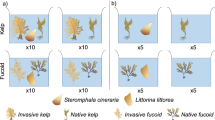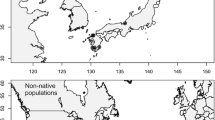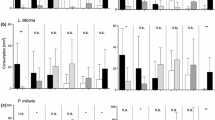Abstract
The success of introduced species is often attributed to release from co-evolved enemies in the new range and a subsequent decreased allocation to defense (EICA), but these hypotheses have rarely been evaluated for systems with low host-specificity of enemies. Here, we compare herbivore utilization of the brown seaweed, Fucus evanescens, and its coexisting competitors both in its native and new ranges, to test certain predictions derived from these hypotheses in a system dominated by generalist herbivores. While F. evanescens was shown to be a preferred host in its native range, invading populations supported a less diverse herbivore fauna and it was less preferred in laboratory choice experiments with important herbivores, when compared to co-occurring seaweeds. These results are consistent with the enemy release hypothesis, despite the fact that the herbivore communities in both regions were mainly composed of generalist species. However, in contrast to the prediction of EICA, analysis of anti-grazing compounds indicated a higher allocation to defense in introduced compared to native F. evanescens. The results suggest that the invader is subjected to less intense enemy control in the new range, but that this is due to an increased allocation to defense rather than release from specialized herbivores. This indicates that increased resistance to herbivory might be an important strategy for invasion success in systems dominated by generalist herbivores.



Similar content being viewed by others
References
Amade P, Lemée R (1998) Chemical defence of the mediterranean alga Caulerpa taxifolia: variations in caulerpenyne production. Aquat Toxicol 43:287–300
Amsler C, Fairhead V (2006) Defensive and sensory chemical ecology of brown algae. Adv Bot Res (in press)
Barker KM, Chapman ARO (1990) Feeding preferences of periwinkles among four species of Fucus. Mar Biol 106:113–118
Bellan-Santini D, Arnaud PM, Bellan G, Verlaque M (1996) The influence of the introduced tropical alga Caulerpa taxifolia, on the biodiversity of the Mediterranean marine biota. J Mar Biol Assoc UK 76:235–237
Blossey B, Nötzold R (1995) Evolution of increased competitive ability in invasive nonindigenous plants: a hypothesis. J Ecol 83:887–889
Coulatti RI, Ricciardi A, Grigorovich IA, MacIsaac HJ (2004) Is invasion success explained by the enemy release hypothesis? Ecol Lett 7:721–733
Denton AB, Chapman ARO (1991) Feeding preferences of gammarid amphipods among four species of Fucus. Mar Biol 109:503–506
Elton CS (1958) The ecology of invasions by animals and plants. Methuen, London
Geiselman JA, McConnell OJ (1981) Polyphenols in brown algae Fucus vesiculosus and Ascophyllum nodosum: chemical defences against the marine herbivorous snail, Littorina littorea. J Chem Ecol 7:1115–1133
Hay ME, Steinberg PD (1992) The chemical ecology of plant–herbivore interactions in marine versus terrestrial communities. In: Rosenthal GA, Berenbaum MR (eds) Herbivores: their interactions with secondary plant metabolites. Volume II: Evolutionary and ecological processes. Academic, San Diego, pp 371–413
Hylmö DEv (1933) Algenimmigration nach der schwedischen Westküste. Bot Notiser 1933:377–390
Joshi J, Vrieling K (2005) The enemy release and EICA hypothesis revisited: incorporating the fundamental difference between specialist and generalist herbivores. Ecol Lett 8:704–714
Keane RM, Crawley MJ (2002) Exotic plant invasions and the enemy release hypothesis. Trends Ecol Evol 17:164–170
Lau SCK, Qian P-Y (1997) Phlorotannins and related compounds as larval settlement inhibitors of the tube-building polychaete Hydroides elegans. Mar Ecol Prog Ser 159:219–227
Little C, Kitching J (1996) Biology of rocky shores. Oxford University Press, Oxford
Lüder UH, Clayton MN (2004) Induction of phlorotannins in the brown macroalga Eklonia radiata (Laminariales, Phaeophyta) in response to simulated herbivory—the first microscopic study. Planta 218:928–937
Mack RN, Simberloff D, Lonsdale WM, Evans H, Clout M, Bazzaz FA (2000) Biotic invasions: causes, epidemiology, global consequences, and control. Ecol Appl 10:689–710
Maron JL, Vilà M (2001) When do herbivores affect plant invasion? Evidence for the natural enemies and biotic resistance hypothesis. Oikos 95:361–373
Müller-Schärer H, Schaffner U, Steinger T (2004) Evolution in invasive plants: implications for biological control. Trends Ecol Evol 1971:417–422
Parker JD, Hay ME (2005) Biotic resistance to plant invasion? Native herbivores prefer non-native plants. Ecol Lett 8:959–967
Pavia H, Toth GB (2000) Inducible chemical resistance to herbivory in the brown seaweed Ascophyllum nodosum. Ecology 81:3212–3225
Pavia H, Cervin G, Lindgren A, Åberg P (1997) Effects of UV-B radiation and simulated herbivory on phlorotannins in the brown alga Ascophyllum nodosum. Mar Ecol Prog Ser 157:139–146
Pavia H, Carr H, Åberg P (1999) Habitat and feeding preferences of the crustacean mesoherbivores inhabiting the brown seaweed Ascophyllum nodosum (L.) Le Jol. and its epiphytic macroalgae. J Exp Mar Biol Ecol 236:15–32
Peterson CH, Renaud PE (1989) Analysis of feeding preference experiments. Oecologia 80:82–86
Pimentel D, Lach L, Zuniga R, Morrison D (2000) Environmental and economic costs of nonindigenous species in the United States. BioScience 50:53–65
Powell HT (1957) Studies in the genus Fucus L. II. Distribution and ecology of forms of Fucus distichus L. Emend. Powell in Britain and Ireland. J Mar Biol Assoc UK 36:663–693
Ragan MA, Glombitza K-W (1986) Phlorotannins, brown algal polyphenols. Prog Phycol Res 4:129–241
Reid DG (1996) Systematics and evolution of Littorina. Ray Society, London
Schaffelke B, Evers D, Walhorn A (1995) Selective grazing of the isopod Idotea baltica between Fucus evanescens and F. vesiculosus from Kiel Fjord (western Baltic). Mar Biol 124:215–218
Strong DR, Lawton JH, Soutwood R (1984) Insects on plants. Community patterns and mechanisms. Blackwell, Oxford
Toth G, Langhamer O, Pavia H (2005) Inducible and constitutive defenses of valuable seaweed tissues: consequences for herbivore fitness. Ecology 86:612–618
Trowbridge CD (1995) Establishment of the green alga Codium fragile ssp. tomentosoides on New Zealand rocky shores current distribution and invertebrate grazers. J Ecol 83:949–965
Van Alstyne KL (1988) Herbivore grazing increases polyphenolic defences in the intertidal brown alga Fucus distichus. Ecology 69:655–663
Van Alstyne KL (1990) Effects of wounding by the herbivorous snails Littorina sitkana and L. scutulata (Mollusca) on growth and reproduction of the intertidal alga Fucus distichus (Phaeophyta). J Phycol 26:412–416
Van Alstyne KL (1995) Comparison of three methods for quantifying brown algal polyphenolic compounds. J Chem Ecol 21:45–58
Viejo RM (1999) Mobile epifauna inhabiting the invasive Sargassum muticum and two local seaweeds in northern Spain. Aquat Bot 64:131–149
Watson DC, Norton TA (1985) Dietary preferences of the common periwinkle, Littorina littorea (L.). J Exp Mar Biol Ecol 88:193–211
Watson DC, Norton TA (1987) The habitat and feeding preferences of Littorina obtusata (L.) and L. mariae Sacchi et Rastelli. J Exp Mar Biol Ecol 112:61–72
Wikström SA, Pavia H (2004) Chemical settlement inhibition versus post-settlement mortality as an explanation for differential fouling of two congeneric seaweeds. Oecologia 138:223–230
Wikström SA, von Wachenfeldt T, Kautsky L (2002) Establishment of the exotic species Fucus evanescens C.Ag. (Phaeophyceae) in Öresund, Southern Sweden. Bot Mar 45:510–517
Vitousek PM, D’Antonio CM, Loope LL, Westbrooks R (1996) Biological invasions as global environmental change. Am Sci 84:468–478
Worm B, Chapman ARO (1998) Relative effects of elevated grazing pressure and competition from a red algal turf on two post-settlement stages of Fucus evanescens C. Ag. J Exp Mar Biol Ecol 220:247–268
Yates JL, Peckol P (1993) Effects of nutrient availability and herbivory on polyphenolics in the seaweed Fucus vesiculosus. Ecology 74:1757–1766
Acknowledgements
We thank G. Cervin and M. Karlsson for help with phlorotannin analyses, O. Eriksson, J. Ehrlén and two anonymous reviewers for comments on the manuscript and the staff at Tjärnö Marine Biological Laboratory and Sandgerði Marine Centre for hospitality and practical assistance. MBS wish to thank Agnar Ingólfsson for his valuable support. Financial support was provided by the Swedish Environmental Protection Agency, the Swedish Research council through contracts 621-2002-289 and 621-2004-2658, the European Union through the European Regional Development Fund (Objective 2 West Sweden), the Icelandic Centre for Research (Rannís) and Stockholm Marine Research Centre. All experiments complied with the laws of Sweden and Iceland.
Author information
Authors and Affiliations
Corresponding author
Additional information
Communicated by Julia Koricheva
Rights and permissions
About this article
Cite this article
Wikström, S.A., Steinarsdóttir, M.B., Kautsky, L. et al. Increased chemical resistance explains low herbivore colonization of introduced seaweed. Oecologia 148, 593–601 (2006). https://doi.org/10.1007/s00442-006-0407-2
Received:
Accepted:
Published:
Issue Date:
DOI: https://doi.org/10.1007/s00442-006-0407-2




